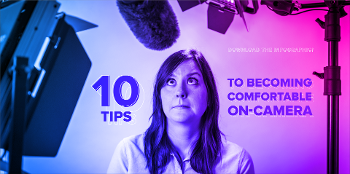It’s your fourth Zoom call today, and it’s not even lunch.
Whether the meeting is internal, client-facing, or to catch up with your mom, it’s safe to say you’re over it. You slump back in your chair, arms folded, staring at the little square at the bottom of the screen, just trying your best not to yawn as your eyes glaze over.
It’s not easy, this new normal. The constant demand that you give and receive undivided attention isn’t natural.
Video chats mean we need to work harder to process non-verbal cues like facial expressions, the tone and pitch of the voice, and body language. In short, we’re constantly exhausted just from trying to communicate.
But this exhaustion can manifest itself in other harmful ways. When we get tired and frustrated, it’s easy to send negative signals we don’t intend. Now more than ever, the attention we give to body language on any video chatting platform is crucial.
As a video production and marketing agency, we here at VMG Studios have been making people look their best and broadcast the right signals on-camera for years. Recently, we have taken what we’ve learned from the studio and have pivoted to focus the same attention on what we do in front of the webcam.
Whether we’re talking about entire full-scale film products or digital communications, we have extensive experience in getting our virtual message across. We know what works, what doesn’t, and how to position ourselves and others (literally!) for success.
In this article, we’re going to break down the dos and don’ts of expression on video conferencing platforms, as well as what to watch out for in others.
On-Camera Tips for Video Conferencing
First and foremost, it’s important to address some of the more fundamental components of an on-camera presence. These might sound like common knowledge, but they are also the easiest elements to let slide over time.
The good news is that these tips are easy to keep at the forefront of our minds and adjust accordingly.
1. Smile
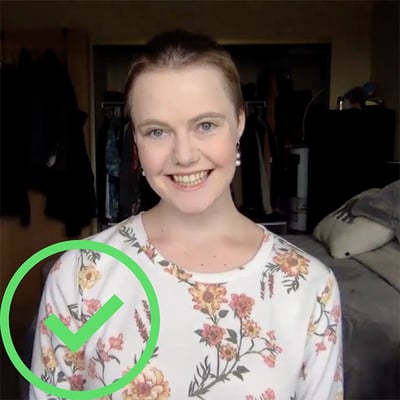
A warm smile at the beginning of a meeting sets the tone more than anything else. It shows that you want to be there, that you can be trusted, and quite simply that you’re a happy and positive person.
2. Dress
While not strictly body language, per se, the way we dress has an enormous impact on how we carry ourselves and how we are perceived professionally. The old adage rings true; dress for success. Even though you’re at home (and we all know you’re not wearing pants), making yourself look and feel professional goes a long way toward the impressions you create.
Pro tip: Avoid wearing busy patterns. Solid, dark colors show up the best on video.
3. Environment & Equipment
There are tons of tips and tricks to make sure that your home office is inviting and professional. But to sum it up, make sure that your face is well lit, that your space is free of distractions, and that you follow the rule of thirds when positioning yourself in front of the camera.
To follow the rule of thirds, imagine your screen being cut up into nine boxes (tic-tac-toe style). You’ll want your eyes to line up about where the top of the true center box meets the bottom of the top center box. This arrangement will enhance your visual appeal and balance on screen.
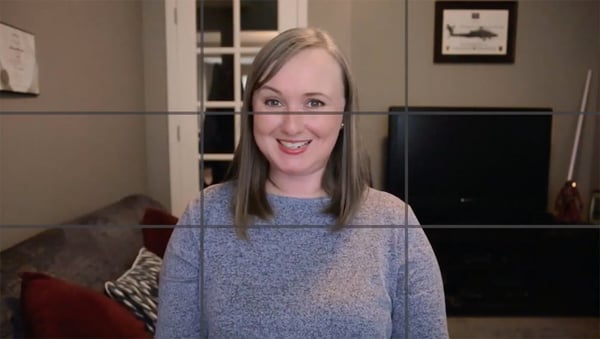 To learn more about the rule of thirds and other tips to recording high-quality video at home, check out this video from VMG Studios senior creative producer, Shawna Mascarelli.
To learn more about the rule of thirds and other tips to recording high-quality video at home, check out this video from VMG Studios senior creative producer, Shawna Mascarelli.
Again, while this might not seem strictly related to body language, it’s all about the perceptions that the folks on the other side of the webcam have of you. If your environment is set up to make you look and feel your best, that will translate.
CLICK HERE FOR A FREE CHECKLIST ON RECORDING VIDEO AT HOME
4. Posture
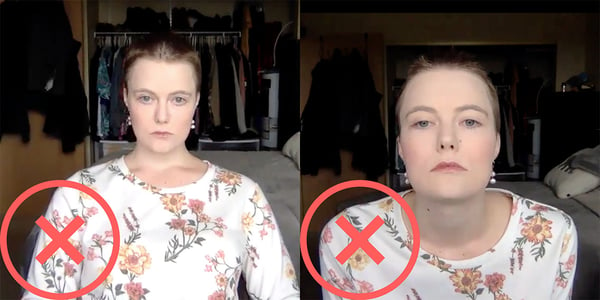
Sit. Up. Straight. Perhaps you’re reminded of a parental scolding at the dinner table, but this one is important.
Today, more than 80% of Americans suffer health issues related to poor posture at some point in their lives. Besides this rather upsetting statistic, slouching over your computer can give the impression that you are tense or tired, and slouching down in your chair can give the impression that you couldn’t care less about what’s happening on screen.
Boredom, depression, disengagement, and in some cases, submission, are all negative signals that can be avoided just by sitting up straight.
Not only should you check in with yourself to ensure you’re sitting correctly, but you can also make sure your workspace at home is ergonomically sound to support proper posture.
5. Listen
Seems obvious, doesn’t it? However, because of the unnatural barrier we face with video communications, our brain doesn’t always signal our bodies to behave as we normally would during a conversation.
Active listening, that is, showing your conversation partner through physical cues that you hear and understand them, is an important part of establishing a positive rapport.
Examples of these physical cues include nodding the head, engaging the eyebrows, and slightly leaning in (but not slouching!).
CLICK THE IMAGE BELOW FOR A FREE INFOGRAPHIC
Subconscious Body Language Behaviors
Just about everything we’ve discussed so far has been about conscious actions that lead to what are often unconscious or unintended signals. But there are a whole host of other actions that human beings ascribe meaning to, and we don’t even realize we’re doing them – let alone realize that we’re making snap judgments when others do them.
The following behaviors are all things that you can look for in yourself, but it will be easier to see them in others. Next time you’re on a video call, try to look for any of these subtle cues. You’ll be surprised at how common they are.
It’s All About the Eyes
Being aware of where it looks like you are looking is key. Though making eye contact isn’t truly possible through a screen, you can simulate what it would feel and look like just by being conscious of where others will see your gaze.
When others are speaking, it’s generally okay to look at them wherever they are on the screen (they’re probably watching themselves anyway!). But when it’s your turn to speak, try getting into the habit of looking directly at the camera. Switching back and forth allows you to simulate natural eye contact and create an atmosphere where people feel recognized, heard, and understood.
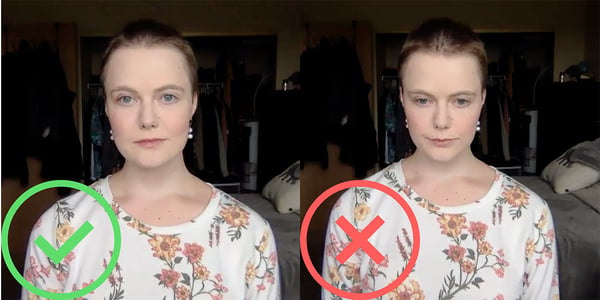
Look at the difference in the pictures above! In the image on the left, I’m looking right into the camera. On the right, I’m looking at the images of my coworkers in the video chat. Though I was looking directly at someone else speaking on my screen, it looks like I’m not even looking at the monitor at all.
One key tip is to remove the view you have of yourself. Once you’re sure that you’re in the proper view of the camera etc., you no longer need to see yourself. After all, it’s not like we typically watch ourselves when we have conversations in “real” life! (Here’s how to remove your view of yourself in Zoom: Hiding or Showing My Video on My Display.)
Another thing to be aware of with your eyes is how often you’re blinking. It has been proven that people who blink more rapidly than normal seem dishonest, most likely because when we do blink rapidly, it’s a sign that we are anxious.
Crossing Your Arms
Is it comfortable? Yes. Does it look good? No.
Crossing the arms is a universal sign of being closed off or unwelcoming. It makes it look like you don’t trust the person you’re speaking with, which in turn, makes it harder for them to trust you.
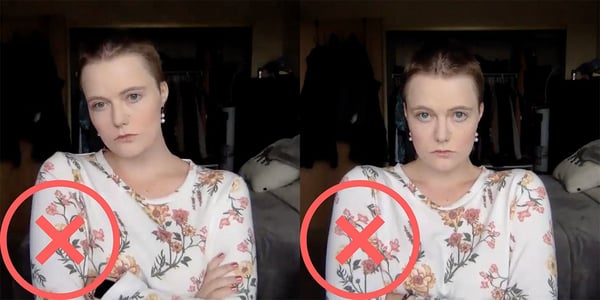
In conjunction with your posture and micro facial expressions, crossing your arms can have other negative connotations too.
In the image on the left, I’m slightly leaned back with my head titled which seems to say that I’m above it all, and extremely self-important. In the image on the right, my shoulders are tense and raised, signaling almost the opposite – that I don’t want to be there because I feel that I shouldn’t be, or that I’ve done something wrong.
Gesturing
People like it when they can see your hands. It establishes trust, signaling to their brain that you have nothing to hide.

Most people naturally gesticulate while they’re talking, and that’s good! Not only does it help to illustrate your point, providing yet more body language clues as to the intent of your words, but it helps release pent up anxious energy that often comes with speaking in a professional setting.
The trick is to keep the gestures within view of the camera and deliberate enough to not distract or annoy your audience.
READ: 5 STRATEGIES TO COMBAT VIDEO CONFERENCING (ZOOM) FATIGUE
The Neck
Much can be revealed when people touch their neck. In short, don’t do it if you can avoid it.
Touching the back of the neck is a sign of feeling distressed and looking for a way to calm down.

Some people rub or massage the back of the neck around the base of the skull, while others stroke just under the chin, tugging at the fleshy area of the neck. This area is rich with nerve endings that reduce blood pressure and lower the heart rate when stimulated. During a meeting, these actions are signaling that you are looking for a way out, or some relief, from the situation at hand that is causing you to feel uncomfortable.
Running the Tongue Over the Teeth with Closed Lips
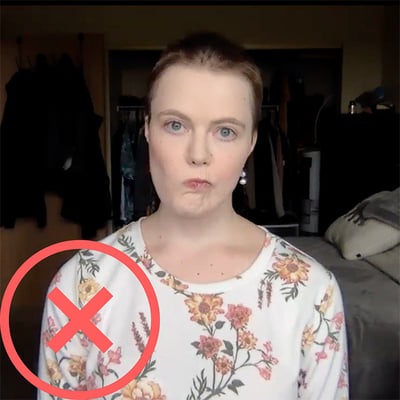
This is an odd, more specific one. This cue signals a need to pacify. The tongue on teeth provides a soothing tactile stimulus aimed at reducing anxiety.
Think of your tongue sweeping across your teeth or lips the same way you would about running your palms over your thighs, massaging your own hands, stroking the back of your head, etc. These are all common, natural ways we soothe ourselves on a daily basis when we are presented with stressful situations. Again, this action signals the negative impression that you are nervous and uncomfortable, seeking some amount of relief.
Face Touching
There are a million different ways that human beings send signals by touching the areas around or related to the face, and almost none of them are positive.

Tugging or playing with the ear, for example, is a psychological callback to the old “hear no evil” saying. This is the sophisticated adult version of the hands-over-both-ears gesture used by the young child who wants to block out her parent's reprimands. Essentially, you’re telling whoever is speaking that you don’t like what they’ve said.
More generally, face touching or resting the face on your hands simply indicates boredom, or that you’re ready to move on.
Looking Professional on a Video Conference
It’s not possible to keep all of these bad habits at bay all the time – after all, they are literally our first nature. But by remaining aware of what your body is signaling, you can begin to practice fighting the more unconstructive instincts and can better control the outcome of your meetings.
Remember, try to keep your hands visible while you speak, especially for the purpose of gesticulating, but don’t touch your face, hair, or neck. You want to send the signals that you are at ease, present, open, interested, and trustworthy.
Body language is, after all, a language. It takes time and effort to master not only how you use it to communicate, but how to decipher what others are communicating to you. Doing so over video adds another layer of obscurity, but never fear! Humans are nothing if not used to change and challenge.
Click the image below to download a free checklist for recording high-quality video on your computer



